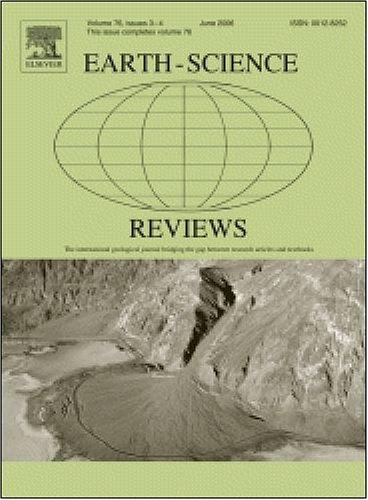The ichnogenus Ophiomorpha Lundgren, 1891: Taxonomy and environmental distribution
IF 10.8
1区 地球科学
Q1 GEOSCIENCES, MULTIDISCIPLINARY
引用次数: 0
Abstract
The classic trace fossil Ophiomorpha ranks among the most common biogenic sedimentary structures on earth and has been widely reported from Mesozoic and Cenozoic strata. Originally thought to be restricted to shallow-marine environments, subsequently Ophiomorpha was also recognised in marginal-marine and deep-marine deposits. A proper application for palaeoenvironmental reconstructions is hindered by inadequately defined ichnospecies and gradual transitions among them. This review reveals five ichnospecies as valid, each of which occurs in a particular sedimentary environment. Ophiomorpha saxonica and O. nodosa are common in shallow-marine and nearshore environments. Ophiomorpha nodosa may cooccur and intergrade with O. irregulairis, which reaches far into marginal-marine environments with brackish-water conditions. Ophiomorpha rudis and O. annulata are deep-marine forms, probably reaching up to the upper continental slope. Care must be taken assigning burrows with a knobby lining from continental deposits to Ophiomorpha, which might be more conformable with other, similar ichnotaxa. Based on modern analogues and body fossils within their burrows, Ophiomorpha nodosa and partly O. saxonica are believed to result from the burrowing activity of callianassid shrimp. Decapod crustaceans belonging to Axiidea (mud shrimp, ghost shrimp and burrowing shrimp) and Gebiidea (mud lobsters and mud shrimp) are the likely producers of the other ichnospecies. A combined deposit- and suspension-feeding can be inferred for the tracemaker. Intimate association of Ophiomorpha with minute mud-lined burrows suggests the occurrence of brooding chambers and emergence of juvenile crustaceans.
蛇麻属,1891:分类与环境分布
蛇胚岩是地球上最常见的生物成因沉积构造之一,在中、新生代地层中被广泛报道。最初认为蛇胚藻只存在于浅海环境中,后来在边缘海和深海沉积物中也发现了蛇胚藻。鱼类种类的不充分界定和它们之间的逐渐过渡阻碍了古环境重建的正确应用。这篇综述揭示了5种有效的鱼种,每一种都发生在特定的沉积环境中。在浅海和近岸环境中常见的有蛇胚和蛇胚。瘤形藻可与不规则藻共生,并可深入到咸淡水条件的边缘海洋环境。蛇苔和环叶蛇苔是深海形态,可能延伸到大陆上斜坡。必须小心地将大陆沉积物中带有结瘤衬里的洞穴分配给蛇形目,因为蛇形目可能与其他类似的鱼形目更适应。根据现代类似物和洞穴内的身体化石,nodosa和部分O. saxonica被认为是由callianassid虾的穴居活动产生的。属于轴总目(泥虾、鬼虾和穴居虾)和泥总目(泥虾和泥虾)的十足甲壳类动物可能是其他鱼种的生产者。对于示踪器,可以推断出沉积和悬浮液的联合注入。蛇胚与细小的泥衬里洞穴的密切联系表明有孵卵室的存在和幼年甲壳类动物的出现。
本文章由计算机程序翻译,如有差异,请以英文原文为准。
求助全文
约1分钟内获得全文
求助全文
来源期刊

Earth-Science Reviews
地学-地球科学综合
CiteScore
21.70
自引率
5.80%
发文量
294
审稿时长
15.1 weeks
期刊介绍:
Covering a much wider field than the usual specialist journals, Earth Science Reviews publishes review articles dealing with all aspects of Earth Sciences, and is an important vehicle for allowing readers to see their particular interest related to the Earth Sciences as a whole.
 求助内容:
求助内容: 应助结果提醒方式:
应助结果提醒方式:


